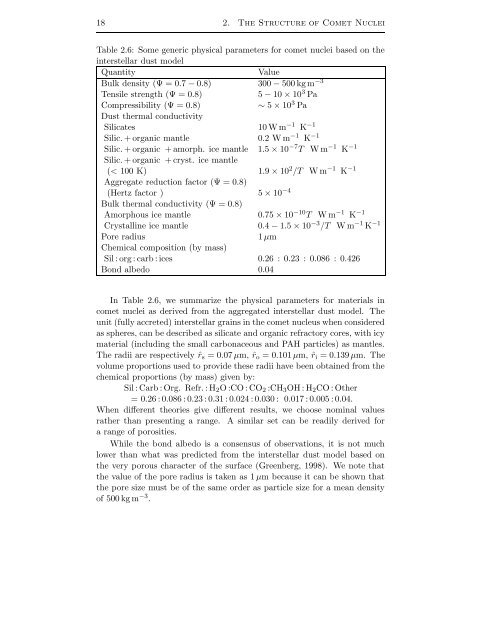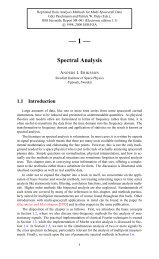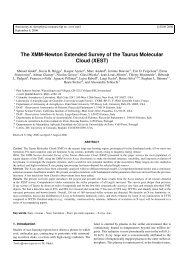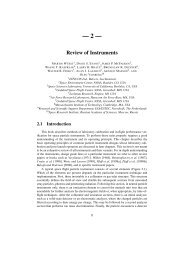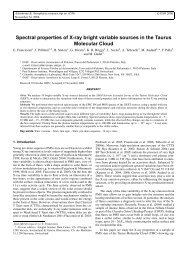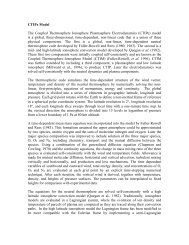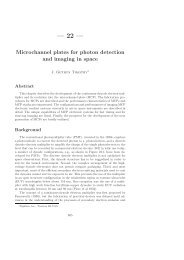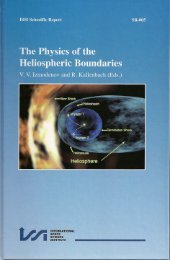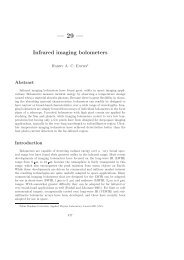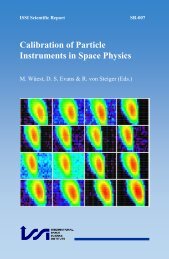- Page 2: HEAT AND GAS DIFFUSION IN COMET NUC
- Page 5 and 6: iv Contents 4.4 Boundary Conditions
- Page 7 and 8: vi Contents Appendix A: Orbital Par
- Page 9 and 10: viii List of Figures 5.1 Change in
- Page 11 and 12: x List of Figures 9.3 Model of 46P/
- Page 13 and 14: xii List of Figures 10.12Final abun
- Page 15 and 16: xiv List of Tables 10.2 Initial par
- Page 17 and 18: xvi Foreword The content of this bo
- Page 19 and 20: xviii Preface several properties, n
- Page 21 and 22: xx Symbols and Constants
- Page 23 and 24: xxii Symbols and Constants Symbol M
- Page 25 and 26: xxiv Symbols and Constants
- Page 27 and 28: xxvi Symbols and Constants
- Page 29 and 30: 2 1. Introduction - Observational O
- Page 31 and 32: 4 1. Introduction - Observational O
- Page 33 and 34: 6 1. Introduction - Observational O
- Page 35 and 36: 8 1. Introduction - Observational O
- Page 37 and 38: 10 2. The Structure of Comet Nuclei
- Page 39 and 40: 12 2. The Structure of Comet Nuclei
- Page 41 and 42: 14 2. The Structure of Comet Nuclei
- Page 43: 16 2. The Structure of Comet Nuclei
- Page 47 and 48: 20 2. The Structure of Comet Nuclei
- Page 49 and 50: 22 2. The Structure of Comet Nuclei
- Page 51 and 52: 24 2. The Structure of Comet Nuclei
- Page 53 and 54: 26 2. The Structure of Comet Nuclei
- Page 55 and 56: 28 2. The Structure of Comet Nuclei
- Page 57 and 58: 30 2. The Structure of Comet Nuclei
- Page 59 and 60: 32 3. Physical Processes in Comet N
- Page 61 and 62: 34 3. Physical Processes in Comet N
- Page 63 and 64: 36 3. Physical Processes in Comet N
- Page 65 and 66: 38 3. Physical Processes in Comet N
- Page 67 and 68: 40 3. Physical Processes in Comet N
- Page 69 and 70: 42 3. Physical Processes in Comet N
- Page 71 and 72: 44 3. Physical Processes in Comet N
- Page 73 and 74: 46 3. Physical Processes in Comet N
- Page 75 and 76: 48 3. Physical Processes in Comet N
- Page 77 and 78: 50 3. Physical Processes in Comet N
- Page 79 and 80: 52 3. Physical Processes in Comet N
- Page 81 and 82: 54 3. Physical Processes in Comet N
- Page 83 and 84: 56 3. Physical Processes in Comet N
- Page 85 and 86: 58 4. Basic Equations or trapped in
- Page 87 and 88: 60 4. Basic Equations ing through t
- Page 89 and 90: 62 4. Basic Equations the heat tran
- Page 91 and 92: 64 4. Basic Equations • Initial p
- Page 93 and 94: 66 4. Basic Equations orders of mag
- Page 95 and 96:
68 4. Basic Equations instantaneous
- Page 97 and 98:
70 4. Basic Equations g = (4π/3)G
- Page 99 and 100:
72 4. Basic Equations More advanced
- Page 101 and 102:
74 4. Basic Equations conductivity
- Page 103 and 104:
76 4. Basic Equations as a correcti
- Page 105 and 106:
78 4. Basic Equations correction fa
- Page 107 and 108:
80 5. Analytical Considerations Imp
- Page 109 and 110:
82 5. Analytical Considerations (19
- Page 111 and 112:
84 5. Analytical Considerations exa
- Page 113 and 114:
86 5. Analytical Considerations Sin
- Page 115 and 116:
88 5. Analytical Considerations Fig
- Page 117 and 118:
90 5. Analytical Considerations Obs
- Page 119 and 120:
92 5. Analytical Considerations of
- Page 121 and 122:
94 5. Analytical Considerations whe
- Page 123 and 124:
96 5. Analytical Considerations dom
- Page 125 and 126:
98 5. Analytical Considerations ava
- Page 127 and 128:
100 6. Numerical Methods Let the ti
- Page 129 and 130:
102 6. Numerical Methods which the
- Page 131 and 132:
104 6. Numerical Methods flux, whil
- Page 133 and 134:
106 6. Numerical Methods single com
- Page 135 and 136:
108 6. Numerical Methods latitudina
- Page 137 and 138:
110 6. Numerical Methods Input para
- Page 139 and 140:
112 6. Numerical Methods Different
- Page 141 and 142:
114 6. Numerical Methods A differen
- Page 143 and 144:
116 7. Comparison of Algorithms The
- Page 145 and 146:
118 7. Comparison of Algorithms 7.2
- Page 147 and 148:
120 7. Comparison of Algorithms gri
- Page 149 and 150:
122 7. Comparison of Algorithms dif
- Page 151 and 152:
124 7. Comparison of Algorithms be
- Page 153 and 154:
126 7. Comparison of Algorithms flu
- Page 155 and 156:
128 7. Comparison of Algorithms rat
- Page 157 and 158:
130 7. Comparison of Algorithms tim
- Page 159 and 160:
132 7. Comparison of Algorithms cri
- Page 161 and 162:
134 7. Comparison of Algorithms
- Page 163 and 164:
136 8. Orbital Effects Figure 8.1:
- Page 165 and 166:
138 8. Orbital Effects the populati
- Page 167 and 168:
140 8. Orbital Effects Many models
- Page 169 and 170:
142 8. Orbital Effects have compell
- Page 171 and 172:
144 8. Orbital Effects • preservi
- Page 173 and 174:
146 8. Orbital Effects Table 8.1: D
- Page 175 and 176:
148 8. Orbital Effects more sungraz
- Page 177 and 178:
150 8. Orbital Effects The standard
- Page 179 and 180:
152 9. Spin Effects Figure 9.1: Ene
- Page 181 and 182:
154 9. Spin Effects Perihelion rota
- Page 183 and 184:
156 9. Spin Effects Perihelion rota
- Page 185 and 186:
158 9. Spin Effects of the spin axi
- Page 187 and 188:
160 9. Spin Effects Figure 9.6: Mod
- Page 189 and 190:
162 9. Spin Effects used to search
- Page 191 and 192:
164 9. Spin Effects Table 9.1: Para
- Page 193 and 194:
166 10. Comparison of Models with O
- Page 195 and 196:
168 10. Comparison of Models with O
- Page 197 and 198:
170 10. Comparison of Models with O
- Page 199 and 200:
172 10. Comparison of Models with O
- Page 201 and 202:
174 10. Comparison of Models with O
- Page 203 and 204:
176 10. Comparison of Models with O
- Page 205 and 206:
178 10. Comparison of Models with O
- Page 207 and 208:
180 10. Comparison of Models with O
- Page 209 and 210:
182 10. Comparison of Models with O
- Page 211 and 212:
184 10. Comparison of Models with O
- Page 213 and 214:
186 10. Comparison of Models with O
- Page 215 and 216:
188 10. Comparison of Models with O
- Page 217 and 218:
190 10. Comparison of Models with O
- Page 219 and 220:
192 10. Comparison of Models with O
- Page 221 and 222:
194 10. Comparison of Models with O
- Page 223 and 224:
196 10. Comparison of Models with O
- Page 225 and 226:
198 11. Internal Properties of Come
- Page 227 and 228:
200 11. Internal Properties of Come
- Page 229 and 230:
202 11. Internal Properties of Come
- Page 231 and 232:
204 11. Internal Properties of Come
- Page 233 and 234:
206 12. Conclusions 12.1 Numerical
- Page 235 and 236:
208 12. Conclusions inferences on t
- Page 237 and 238:
210 12. Conclusions structure of th
- Page 239 and 240:
212 12. Conclusions al.). Up to now
- Page 241 and 242:
214 12. Conclusions
- Page 243 and 244:
Comet q (AU) e R (a) (km) R (b) (km
- Page 245 and 246:
Comet q (AU) e R (a) (km) R (b) (km
- Page 247 and 248:
220 Appendix A
- Page 249 and 250:
Table B1. Constants for Vapour Pres
- Page 251 and 252:
224 Appendix B B.4 Phase Transition
- Page 253 and 254:
226 Glossary Olivine: (Mg, Fe) 2 Si
- Page 255 and 256:
228 Bibliography Belton, M. J. S.,
- Page 257 and 258:
230 Bibliography and thermal evolut
- Page 259 and 260:
232 Bibliography Schwassmann-Wachma
- Page 261 and 262:
234 Bibliography Icarus 72, 535, 19
- Page 263 and 264:
236 Bibliography Harris and E. Bowe
- Page 265 and 266:
238 Bibliography in Chemistry and P
- Page 267 and 268:
240 Bibliography (eds. W. F. Huebne
- Page 269 and 270:
242 Bibliography Discovery of 26 Al
- Page 271 and 272:
244 Bibliography Barucci, M. A., Ar
- Page 273 and 274:
246 Bibliography [10.3, 12.2] Prial
- Page 275 and 276:
248 Bibliography Sekanina, Z., Rota
- Page 277 and 278:
250 Bibliography Not. Roy. Astron.
- Page 279 and 280:
252 Bibliography Arizona Press, 198
- Page 281 and 282:
254 SUBJECT INDEX 207, 208, 210, 21
- Page 283 and 284:
256 SUBJECT INDEX phase transition,
- Page 285:
258 SUBJECT INDEX Tensile strength,


